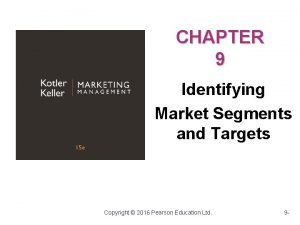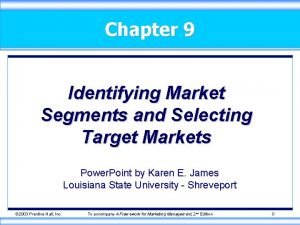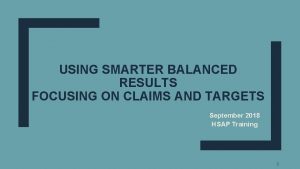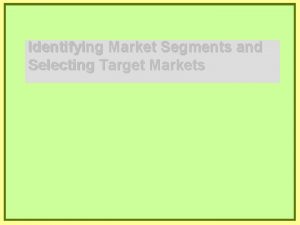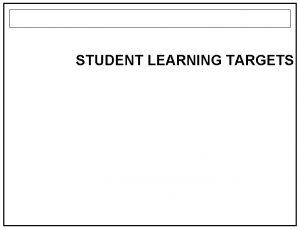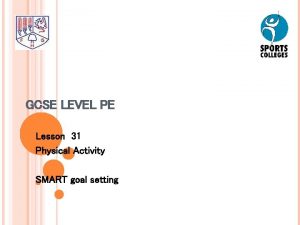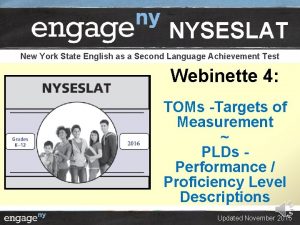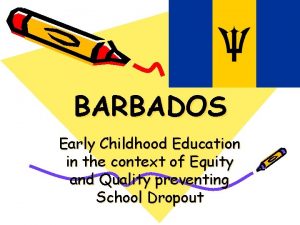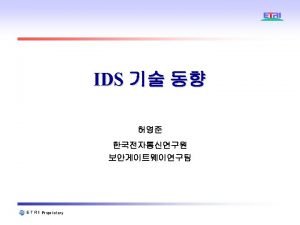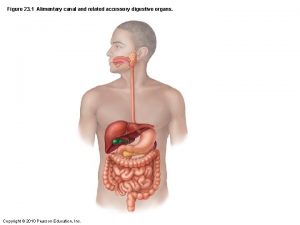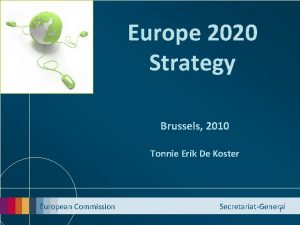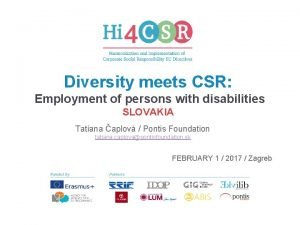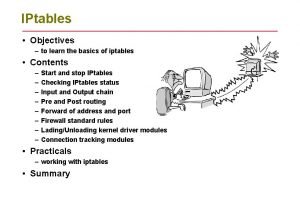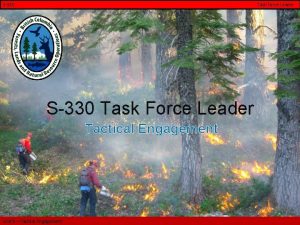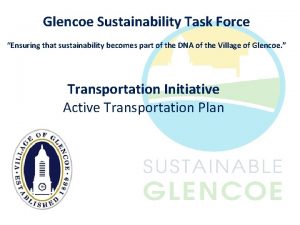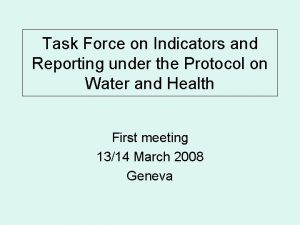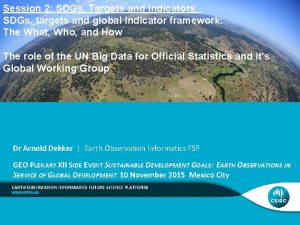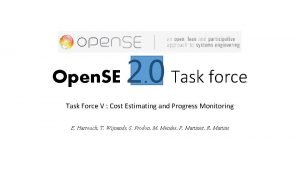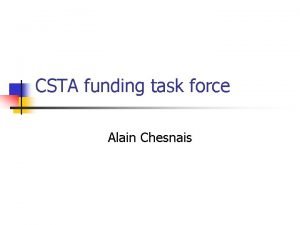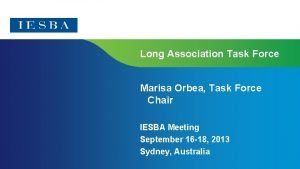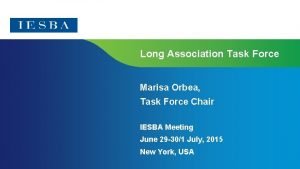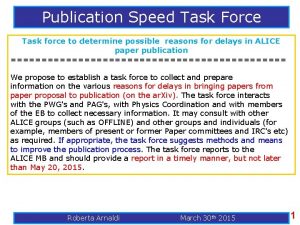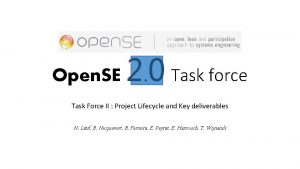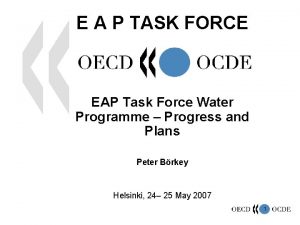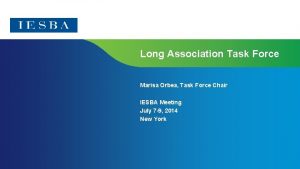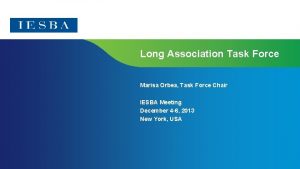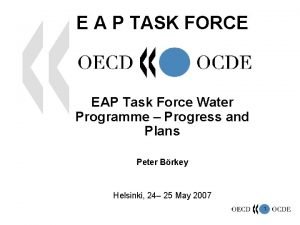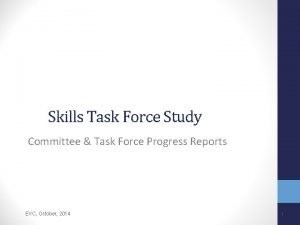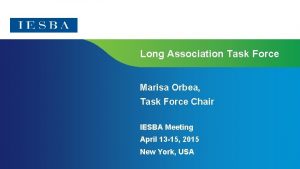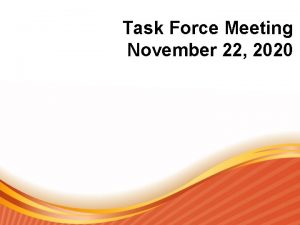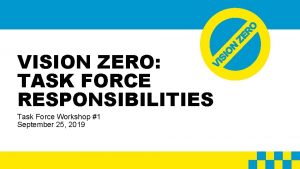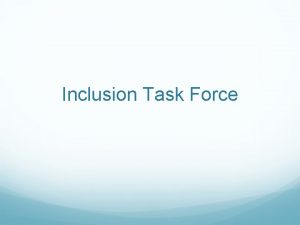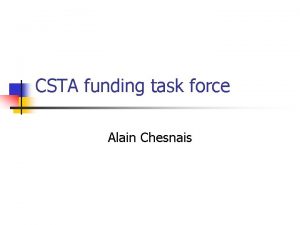Task Force on Indicators and Reporting Targets and
































- Slides: 32

Task Force on Indicators and Reporting Targets and indicators 13 - 14 March 2008 1 TFIR 1

Basic principles for target setting (1) A target can be many things => flexibility to adapt to country needs – Development of a law, monitoring programme, water management plans, introduction of a new approach – Institutional framework – Capacity building or a study – Social and economic issues – National / local / pilot projects – Specific parameter => But in all cases it must be possible to assess progress 13 - 14 March 2008 1 TFIR 2

Basic principles for target setting (2) Need for a holistic approach => importance of the process Need to promote harmonization Need to have a meaningful reporting system that allows building a coherent picture for the whole region 13 - 14 March 2008 1 TFIR 3

Guidelines approach For most areas illustrate options for target setting: non-comprehensive but useful “shopping list” For few core areas: common indicators which become part of the reporting system =>Is it useful/agreeable? =>Do we need definitions, standards? => Which can be “core” common indicators? 13 - 14 March 2008 1 TFIR 4

Consequences for reporting What is/are your target(s) under article 6 (2) xx and related target date(s)? What were the baseline conditions? What are the current conditions? Shortly describe action undertaken to achieve target(s), and planned activities. What is your target for the percentage of population with access to water and related target date(s)? (urban/rural) What were the baseline conditions? (urban/rural) What is the current percentage of population with access to water? (urban/rural) Shortly describe action undertaken to achieve target(s), and planned activities. 13 - 14 March 2008 1 TFIR 5

Quality of drinking-water (Art 6(2)(a)) Percentage of samples that fails to meet the standards for – E. coli All water intended for drinking: not detectable in any 100 ml Treated water entering the distribution system: not detectable in any 100 -ml sample Treated water in the distribution system: not detectable in any 100 -ml sample – Enterococci – Pseudomonas aeruginosa Ref. GDWQ Vol 3 pp. 143, 288, 238 13 - 14 March 2008 1 TFIR 6

Quality of drinking-water (Art 6(2)(a)) chemical Percentage of samples that fails to meet chemical water quality – Countries to decide in accordance with local needs (Fe, Pb, Cu, NO 3/As…) – Not weighted, but by water supplier – Quality at tap – Ten core parameters from amongst Annex 1 Part B of the DWD GDWQ , Chemical safety of drinking-water 13 - 14 March 2008 1 TFIR 7

Reduction of the scale of waterrelated disease (Art 6(2)(b)) Uses Incidence Prevalence Expresses the risk of becoming ill The main measure of acute diseases or conditions, but also chronic Most useful for studies of causation Number of existing cases at a given point in time Estimates the probability of the population being ill at the period of time being studied 13 - 14 March 2008 Study of chronic diseases and implications for the health services 1 TFIR 8

Reduction of the scale of waterrelated disease (Art 6(2)(b)) Incidence I: rate at which new events occur in a certain population during a defined time period Number of new events in spec. period/ Number of persons exposed during that period Prevalence P: number of cases in a defined population at a particular point in time Number of people with the disease at spec. time Number of people in the pop at risk at the spec. time Bonita, Beaglehole, Kjellstrom Basic epidemiology WHO Geneva 13 - 14 March 2008 1 TFIR 9

Reduction of the scale of waterrelated disease (Art 6(2)(b)) Outbreak – Two people experience similar illness after exposure to water and health – Problems remain with case definitions, clinical analytical capacity etc 13 - 14 March 2008 1 TFIR 10

Access to drinking water (Art 6(2)(c)) Percentage of population with access to safe drinking water connected to a public supply according to Wat. San_Ex 1 Percentage of population with access to an improved drinking water source Focus on rural areas / sparsely populated areas Social/affordability issues 13 - 14 March 2008 1 TFIR 11

Access to sanitation (Art 6(2)(d)) Access to improved sanitation (JMP) Percentage of population served by sewerage connections and wastewater treatment plants (primary, secondary and tertiary treatment) Wat. San_P 1 Focus on rural area / small settlements 13 - 14 March 2008 1 TFIR 12

Levels of performance of collective and other systems for water-supply (Art 6(2)(e)) - operations Water production m 3/y Water consumption m 3/y Continuity of supply (hrs of pressure) Rate of failure of legally residual chlorine at point of consumption (where required) Main failures Water losses per connection (m/conn/y) 13 - 14 March 2008 1 TFIR 13

Levels of performance of collective and other systems of water-supply (Art 6(2)(e)) - sustainability Energy efficiency (m. Wh/m 3 produced) Unit cost of water to supplier 13 - 14 March 2008 1 TFIR 14

Levels of performance of collective and other systems of sanitation (Art 6(2)(f)) - operations Volume of wastewater produced Volume of wastewater collected Volume of wastewater treated Pump failures (hrs out of service/time unit) 13 - 14 March 2008 1 TFIR 15

Levels of performance of collective and other systems of water-supply (Art 6(2)(f)) - sanitation Energy efficiency (m. Wh/m 3 treated) Unit cost of wastewater treatment to water user 13 - 14 March 2008 1 TFIR 16

Good management practice water supply (Art 6 (2) (f)) National percentage of water production utilities with established and enforced protection zones National percentage of water production utilities with recognized certification (ISO 900 quality man, ISO 14000 env man, ISO 22000 Food safety man, WSP) National percentage of water production utilities with accreditation to national accreditation laboratories 13 - 14 March 2008 1 TFIR 17

Good management practice sanitation (Art 6(2)(f)) Individual utility – Annual mean removal % (BOD/N/P) – Effluent quality target exceedance – Sludge production (m 3 sludge/ m 3 wwater) – Sludge treatment (tonnes/y/treatment method) 13 - 14 March 2008 1 TFIR 18

Good management practice sanitation (Art 6(2)(f)) National level – Number of existing wwtp ( load in pop eq/y) – Number of operational wwtp (with load) – Number of planned wwtp (with load and year of start up) – Number of wwtp slated for upgrade (with load) – Number of dysfunctional wwtp (w/ design load) 13 - 14 March 2008 1 TFIR 19

Untreated wastewater (Art 6(2)(g)(i)) % of wastewater that is not collected % of collected wastewater that is not treated % of collected wastewater that undergoes only primary treatment 13 - 14 March 2008 1 TFIR 20

Untreated storm water overflows (Art 6(2)(g)(ii)) Capacity of sewage collection and treatment plants to cope with stormwater overflow – – – dry weather flow vs storm water flow storage capacity for storm water runoff total number of storm overflows per year Change from combined to separate sewerage systems (pop served) 13 - 14 March 2008 1 TFIR 21

Quality of discharges of waste water Art 6 (2)(h)) Non compliance with limit concentrations (domestic / industrial waster water) Health indicators (faecal coliforms, pathogens) Quantity of dangerous substance released Permit system for discharges / quality control 13 - 14 March 2008 1 TFIR 22

Disposal or reuse of sewage sludge (Art 6(2)(i) first part) Basic statistics – Production (tonne/y or tonne/m 3 treated) – Treatment means – Disposal of raw sludge – Disposal of treated sludge – (nature, agriculture, reused inside and outside the plant) – Cases of non compliance 13 - 14 March 2008 1 TFIR 23

Quality of waste water used for irrigation purposes (Art 6(2)(i) second part) Agriculture – E. coli per 100 ml per area of activity – Helminth eggs per litre per area of activity Aquaculture & protection of workers and local communities – E. coli per 100 ml – Viable trematode eggs per litre WHO Guidelines for the safe use of wastewater, excreta and greywater Vol. 1 Policy and regulatory aspects p 33 13 - 14 March 2008 1 TFIR 24

Quality of waters used as sources for drinking water (Art 6(2)(j) first part) Relevant obligations - EU Water Framework Directive (art. 7(1) - Repelled EU Abstraction Directive (75/440/EEC) - EU Ground Water Directive 2006/118/EC 13 - 14 March 2008 1 TFIR 25

Quality of waters used for bathing (Art 6(2)(j) second part) Microbial quality values – Based on 95 th percentile value of intestinal enterococci / 100 ml and taking into account local conditions WHO (2003) Guidelines for safe recreational water environment Vol 1 Coastal and Freshwater WHO Geneva pp 70 13 - 14 March 2008 1 TFIR 26

Enclosed bathing waters (Art 6(2)(k)) Pool type Heterotrophic TT coli plate count E. Coli P. Legionella aeruginosa spp Public, d <200/ml week <1/100 ml w <1/100 ml d <1/100 ml q Semi public, d <200/ml monthly <1/100 ml m <1/100 ml demand Natural spa n/a <1/100 ml w <10/100 ml <1/100 ml weekly monthly Hot tubs n/a <1/100 ml Weekly <1/100 ml q <1/100 ml monthly WHO (2006) Guidelines for safe recreational water environments Vol 2 WHO Geneva 13 - 14 March 2008 1 TFIR 27

Quality of waters for aquaculture or production of shellfish ((Art 6(2)(j))) EU shellfish (and fish) directive: 79/923/EEC and 2006/44/EEC set standards and requires monitoring for salinity, temperature, DO, As, Cd. . Existence of targets and parameters for waters used for aquaculture or for the production or harvesting shellfish depending on national situation – – – physical parameters biological parameters chemical parameters Compliance with these standards Risk- approach: data on outbreak of shellfish-related diseases Other food-related legislation: 854/2004, 853/2004 etc. 13 - 14 March 2008 1 TFIR 28

Identification and remediation of contaminated sites (Art 6 (2) (l)) Inventory Risk assessment (only related to risk of water-related disease? Remediative action taken (% of sites) 13 - 14 March 2008 1 TFIR 29

Effectiveness of management of water resources (Art 6 (2) (m)) Process related targets – Enabling conditions (laws, regulations, transboundary agreements) – Institutional measures (RBO) – Management instruments (river basin management plans) – Cross-cutting issues (financing, public involvement, education, training) 13 - 14 March 2008 1 TFIR 30

Effectiveness of management of water resources (Art 6 (2) (m)) Quality and quantity aspects – Based on national classification systems / good status – Focus on specific pollutants (pesticides) – Population living under water scarcity – Water exploitation index (national / river basin) – Abstraction of water for domestic needs person 13 - 14 March 2008 1 TFIR 31

Frequency of publication of information on quality of drinking water and other waters (Art 6 (2) (n)) Any period up to three years (art 7 (2)) Other reporting obligations 13 - 14 March 2008 1 TFIR 32
 Tiered task bias task
Tiered task bias task Warehouse goals
Warehouse goals Identifying market segments and targets chapter 9
Identifying market segments and targets chapter 9 Identifying market segments and targets
Identifying market segments and targets Identifying market segments and targets chapter 9
Identifying market segments and targets chapter 9 Five patterns of target market selection
Five patterns of target market selection Identifying market segments and targets
Identifying market segments and targets Pituitary hormones and their targets
Pituitary hormones and their targets Smarter balanced claims and targets
Smarter balanced claims and targets Identifying market segments and targets
Identifying market segments and targets Writing learning targets
Writing learning targets Jim crow laws in what region or regions did it exist
Jim crow laws in what region or regions did it exist Brides magazine targets consumers who are in
Brides magazine targets consumers who are in Targets of change
Targets of change Smart pe gcse
Smart pe gcse Learning targets
Learning targets Final sketch
Final sketch Sample learning targets for reasoning
Sample learning targets for reasoning Learning targets knowledge, reasoning, skill product
Learning targets knowledge, reasoning, skill product Nyseslat targets of measurement
Nyseslat targets of measurement Learning targets helping students aim for understanding
Learning targets helping students aim for understanding The process of customer-driven marketing involves
The process of customer-driven marketing involves Early childhood education barbados
Early childhood education barbados Physical targets
Physical targets Icsa idsc 모니터링 접근방식
Icsa idsc 모니터링 접근방식 Small intestine
Small intestine Europe 2020 targets
Europe 2020 targets Europe 2020 targets
Europe 2020 targets On training targets for supervised speech separation
On training targets for supervised speech separation Iptables command
Iptables command S330 nwcg
S330 nwcg Enemy mechanized infantry symbol
Enemy mechanized infantry symbol Glencoe sustainability task force
Glencoe sustainability task force


